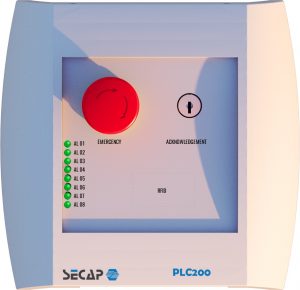PLC200 – EMPA
Highest flexibility
and strongest performance in the field
Emergency panel controller – Power over CAN
The PLC200 system includes Emergency Panel device connected on CAN BUS using RJ45 connector (IN/OUT). Physically the controller finds lodging in the base of the container of the device, processor of management RENESAS series RX600:
- Emergency button (mushroom) with redundant contacts
- Activation key/ lock with redundant contacts
- Two isolated SSR outputs with line integrity control
- Eight programmable LEDs for status, alarms, etc.Integrated MIFARE RFID reader for advanced management.

Kit structure
K-EMPA 18KEMPA0 EMPA 18EMPA01 Modulo Panello di emergenza 1
3PF58 MC645 Conn. volante. 3P P.5.08mm 1
K-EMPA 18KEMPA0 EMPA 18EMPA01 Modulo Panello di emergenza 1
3PF58 MC645 Conn. volante. 3P P.5.08mm 1

CAHN Main Board
Processor 32-bit 120Mhz
64-bit floating-point unit
4 Mbytes program memory
1 Mbyte SRAM
Renesas series RX600 RX66 Mod. R5F566NNDDFP
RJ45 interface CAN bus A
CAN bus B
500ma@24VDC
Insulation 1500V
Local diagnostic 8 LED
System enable Key switch RFID card
Emergency Local Push button Remote Push button
System Status 2 Digital output
Communication dual CAN Bus Power over CAN
Processor 32-bit 120Mhz
64-bit floating-point unit
4 Mbytes program memory
1 Mbyte SRAM
Renesas series RX600 RX66 Mod. R5F566NNDDFP
RJ45 interface CAN bus A
CAN bus B
500ma@24VDC
Insulation 1500V
Local diagnostic 8 LED
System enable Key switch RFID card
Emergency Local Push button Remote Push button
System Status 2 Digital output
Communication dual CAN Bus Power over CAN

Power Over CAN
Power over CAN (PoC) is a technology for wired CAN-bus local area networks that allows the electrical current necessary for the operation of each device to be carried by the data cables rather than by power cords. Doing so minimizes the number of wires that must be strung to install the network.
Power over CAN (PoC) is a technology for wired CAN-bus local area networks that allows the electrical current necessary for the operation of each device to be carried by the data cables rather than by power cords. Doing so minimizes the number of wires that must be strung to install the network.

Cables
RJ45 plugs feature eight pins to which the wire strands of a cable interface electrically. Each plug has eight locations spaced about 1 mm apart into which individual wires are inserted using special cable crimping tools. The industry calls this type of connector 8P8C, shorthand for eight position, eight contact. Ethernet cables and 8P8C connectors must be crimped into the RJ45 wiring pattern to function properly. Technically, 8P8C can be used with other types of connections besides Ethernet; it is also used with RS-232 serial cables, for example. However, because RJ45 is the predominant usage of 8P8C, industry professionals often use the two terms interchangeably.
RJ45 plugs feature eight pins to which the wire strands of a cable interface electrically. Each plug has eight locations spaced about 1 mm apart into which individual wires are inserted using special cable crimping tools. The industry calls this type of connector 8P8C, shorthand for eight position, eight contact. Ethernet cables and 8P8C connectors must be crimped into the RJ45 wiring pattern to function properly. Technically, 8P8C can be used with other types of connections besides Ethernet; it is also used with RS-232 serial cables, for example. However, because RJ45 is the predominant usage of 8P8C, industry professionals often use the two terms interchangeably.



